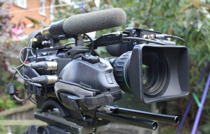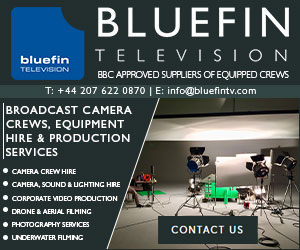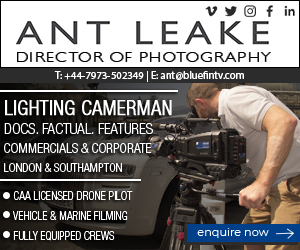Broadcast News
05/12/2012
Big Sensor Cameras, Is This The Future For All Production?

By Cinematographer Alister Chapman
Those of you that read my blog (www.xdcam-user.com) or follow the general production world trends on the Internet will no doubt have seen the meteoric rise the the large sensor camera over the last few years. It all started not with a big sensor camera, but with adapters for use on conventional cameras that used a vibrating or rotating ground glass the same size as a 35mm film frame. A film type or stills camera lens was attached to the adapter and used to project an image on to the ground glass. The ground glass was then shot by the video camera and the system gave the shallow depth of field normally associated with film cameras. Systems like the Letus or MovieTube were fiddly to use, bulky and full of issues, but they did create a very unique and distinctive look that was for some at least highly desirable. Then along came the video equipped DSLR, photo cameras like the Canon 5D MKII with added HD video capability. Suddenly there was a new breed of relatively low cost cameras that in the right hands could produce some pretty amazing results. A lot of the early work done with theses adapters and DSLR cameras was showcased on the Internet, right at the same time as high quality web based video services like Vimeo came to life. A new sub culture came to life on the internet shooting short films, typically music videos, with extremely shallow depth of field and a highly stylised look that took many cues from big budget movies, yet cost very little to put together.
The DSLR's however have issues. They are primarily stills cameras designed to take very high resolution still images, much higher resolution than a video frame. This excess of resolution leads to compromises in the way the video is read from the sensor which can lead to undesirable picture artefacts. However DSLR's have become incredibly popular for short films, web content and even some low cost movie production. Initially they were really only used on productions for the web and internet where many of there shortfalls were less noticeable, but very quickly they started to find there way into ever more prestigious projects and programmes. Not happy with some of the issues related to the use of DSLRs for video, some film makers started to seek out alternatives (the Letus adapters are still in use by some people today) and even started new companies to produce dedicated large sensor video cameras. Not wanting to miss out, the traditional video camera manufacturers decided that they too would like a slice of this emerging market and started developed cameras of their own. The big difference with the new cameras was that these would be designed for video production from the ground up, well at least most of them would.
Now just a few years on the market is full of large sensor cameras. The Super 35mm sized sensor dominates the large sensor market and all of these cameras use a single sensor as opposed to the more traditional 3 chip designs used in most broadcast cameras. The pace of change has been quite dramatic, how many of us thought that we would be considering using PL mount lenses or DSLR lenses for day to day video production just a few years ago? That pace of change continues unabated as now we start to see more and more higher resolution cameras with ever increasing numbers of pixels and new exotic codecs and recording methods like raw.
But what does this mean to mainstream camera crews and operators? Perhaps until now you haven't really taken too much notice of this trend, after all it was mainly an internet thing. Maybe you don't think it will affect you? Well think again! Super 35mm cameras have mainly had an impact on productions seeking to gain a more filmic look. Obviously this includes movies as well as many drama productions but also a lot of documentary productions and even corporate and wedding videos. However the one area where they really don't do so well is in so called "run and gun" scenarios like news, current affairs and observational documentaries. Why? Because the very shallow depth of field that makes these cameras so film like makes keeping that moves towards or away from the camera in focus very difficult.
In addition zoom lenses are either very expensive, extremely heavy or don't track focus like a more conventional broadcast lens. It is possible to get an adapter to use a broadcast lens on a Super 35mm camera, but you still have the shallow depth of field to contend with. But, maybe that's all about to change. Red have been doing this for a while on their cameras, but the Red workflow doesn't lend itself easily to news or run and gun. You see, when you have a very high resolution sensor, much higher than HD, like perhaps many of the 4K and 5K sensors starting to appear now, it's possible at HD to use just the centre portion of the sensor. By using a "centre crop" from a higher resolution sensor you can shoot at a lower resolution but using a smaller image circle. This makes it possible to design a camera that can be switched between being a 4k Super 35 mm camera and an HD 2/3" camera. So one camera with interchangeable lens mounts could be used one day as a Super 35mm movie making tool and the next as a 2/3" news camera with normal broadcast lenses etc. So those of you that think that large sensor cameras are something you don't need to think or know about, beware, maybe one day all cameras will use big sensors. A scary note is that some of the cheaper video capable DSLR's can already do something very similar as a kind of electronic zoom. Video camera technology is advancing at an incredibly fast rate right now. A lot of this is down to new electronic chips that can be programmed to do a multitude of tasks that previously would have required very expensive custom devices. These programmable chips can be erased and re programmed with new firmware so a cameras design and functionality can be changed and improved even after it's left the factory. The down side to this is sometimes in the rush to launch a new camera some of this "firmware" is properly developed and tested, so be careful which cameras you choose to take on any once in a lifetime assignments. Sometimes it's good to let the dust settle before you jump on the new camera band-wagon.
www.alisterchapman.com
www.xdcam-user.com
Those of you that read my blog (www.xdcam-user.com) or follow the general production world trends on the Internet will no doubt have seen the meteoric rise the the large sensor camera over the last few years. It all started not with a big sensor camera, but with adapters for use on conventional cameras that used a vibrating or rotating ground glass the same size as a 35mm film frame. A film type or stills camera lens was attached to the adapter and used to project an image on to the ground glass. The ground glass was then shot by the video camera and the system gave the shallow depth of field normally associated with film cameras. Systems like the Letus or MovieTube were fiddly to use, bulky and full of issues, but they did create a very unique and distinctive look that was for some at least highly desirable. Then along came the video equipped DSLR, photo cameras like the Canon 5D MKII with added HD video capability. Suddenly there was a new breed of relatively low cost cameras that in the right hands could produce some pretty amazing results. A lot of the early work done with theses adapters and DSLR cameras was showcased on the Internet, right at the same time as high quality web based video services like Vimeo came to life. A new sub culture came to life on the internet shooting short films, typically music videos, with extremely shallow depth of field and a highly stylised look that took many cues from big budget movies, yet cost very little to put together.
The DSLR's however have issues. They are primarily stills cameras designed to take very high resolution still images, much higher resolution than a video frame. This excess of resolution leads to compromises in the way the video is read from the sensor which can lead to undesirable picture artefacts. However DSLR's have become incredibly popular for short films, web content and even some low cost movie production. Initially they were really only used on productions for the web and internet where many of there shortfalls were less noticeable, but very quickly they started to find there way into ever more prestigious projects and programmes. Not happy with some of the issues related to the use of DSLRs for video, some film makers started to seek out alternatives (the Letus adapters are still in use by some people today) and even started new companies to produce dedicated large sensor video cameras. Not wanting to miss out, the traditional video camera manufacturers decided that they too would like a slice of this emerging market and started developed cameras of their own. The big difference with the new cameras was that these would be designed for video production from the ground up, well at least most of them would.
Now just a few years on the market is full of large sensor cameras. The Super 35mm sized sensor dominates the large sensor market and all of these cameras use a single sensor as opposed to the more traditional 3 chip designs used in most broadcast cameras. The pace of change has been quite dramatic, how many of us thought that we would be considering using PL mount lenses or DSLR lenses for day to day video production just a few years ago? That pace of change continues unabated as now we start to see more and more higher resolution cameras with ever increasing numbers of pixels and new exotic codecs and recording methods like raw.
But what does this mean to mainstream camera crews and operators? Perhaps until now you haven't really taken too much notice of this trend, after all it was mainly an internet thing. Maybe you don't think it will affect you? Well think again! Super 35mm cameras have mainly had an impact on productions seeking to gain a more filmic look. Obviously this includes movies as well as many drama productions but also a lot of documentary productions and even corporate and wedding videos. However the one area where they really don't do so well is in so called "run and gun" scenarios like news, current affairs and observational documentaries. Why? Because the very shallow depth of field that makes these cameras so film like makes keeping that moves towards or away from the camera in focus very difficult.
In addition zoom lenses are either very expensive, extremely heavy or don't track focus like a more conventional broadcast lens. It is possible to get an adapter to use a broadcast lens on a Super 35mm camera, but you still have the shallow depth of field to contend with. But, maybe that's all about to change. Red have been doing this for a while on their cameras, but the Red workflow doesn't lend itself easily to news or run and gun. You see, when you have a very high resolution sensor, much higher than HD, like perhaps many of the 4K and 5K sensors starting to appear now, it's possible at HD to use just the centre portion of the sensor. By using a "centre crop" from a higher resolution sensor you can shoot at a lower resolution but using a smaller image circle. This makes it possible to design a camera that can be switched between being a 4k Super 35 mm camera and an HD 2/3" camera. So one camera with interchangeable lens mounts could be used one day as a Super 35mm movie making tool and the next as a 2/3" news camera with normal broadcast lenses etc. So those of you that think that large sensor cameras are something you don't need to think or know about, beware, maybe one day all cameras will use big sensors. A scary note is that some of the cheaper video capable DSLR's can already do something very similar as a kind of electronic zoom. Video camera technology is advancing at an incredibly fast rate right now. A lot of this is down to new electronic chips that can be programmed to do a multitude of tasks that previously would have required very expensive custom devices. These programmable chips can be erased and re programmed with new firmware so a cameras design and functionality can be changed and improved even after it's left the factory. The down side to this is sometimes in the rush to launch a new camera some of this "firmware" is properly developed and tested, so be careful which cameras you choose to take on any once in a lifetime assignments. Sometimes it's good to let the dust settle before you jump on the new camera band-wagon.
www.alisterchapman.com
www.xdcam-user.com
Top Related Stories
Click here for the latest broadcast news stories.
17/04/2023
Globecast Launches First Video Public Cloud Video Headend
Globecast has developed and launched the first video public cloud video headend, powered by AWS, for a major European Telco. Globecast joined the AWS
Globecast Launches First Video Public Cloud Video Headend
Globecast has developed and launched the first video public cloud video headend, powered by AWS, for a major European Telco. Globecast joined the AWS
13/04/2023
JVC Professional Video Introduces New Entry-Level Solutions
JVC Professional Video, a division of JVCKENWOOD USA Corporation, Has introduced several new entry-level solutions aimed at smaller production teams,
JVC Professional Video Introduces New Entry-Level Solutions
JVC Professional Video, a division of JVCKENWOOD USA Corporation, Has introduced several new entry-level solutions aimed at smaller production teams,
16/04/2024
EMG / Gravity Media Announces New US Leadership Team
EMG / Gravity Media have announced a new US leadership team following the merger. These strategic appointments underscore the company's dedication to
EMG / Gravity Media Announces New US Leadership Team
EMG / Gravity Media have announced a new US leadership team following the merger. These strategic appointments underscore the company's dedication to
12/04/2024
JVC Releases New KM-IP12S8 Series CONNECTED CAM™ vMix Studio Switchers
JVC Professional Video has released its new KM-IP12S8 Series CONNECTED CAM™ vMix Studio Switchers, complete live video production solutions that provi
JVC Releases New KM-IP12S8 Series CONNECTED CAM™ vMix Studio Switchers
JVC Professional Video has released its new KM-IP12S8 Series CONNECTED CAM™ vMix Studio Switchers, complete live video production solutions that provi
27/10/2017
Agile Remote Cameras Launches New PTZ Cameras & Controller
Agile Remote Cameras has announced the launch of two new PTZ cameras, each with a unique modular design, plus a desktop camera controller. The ARC360
Agile Remote Cameras Launches New PTZ Cameras & Controller
Agile Remote Cameras has announced the launch of two new PTZ cameras, each with a unique modular design, plus a desktop camera controller. The ARC360
14/09/2018
Sony Expands HDC Family With New Live Production System Cameras
Sony has expanded its HDC family with the reveal of four new live production system cameras at IBC. The next generation of system cameras (HDC-P50, HD
Sony Expands HDC Family With New Live Production System Cameras
Sony has expanded its HDC family with the reveal of four new live production system cameras at IBC. The next generation of system cameras (HDC-P50, HD
12/04/2018
Few Lens Optics For Decades, Then Came The Large Digital Sensors
As software takes control of virtually every production and delivery function, cameras and lenses have reached the stage of looking magnificent as the
Few Lens Optics For Decades, Then Came The Large Digital Sensors
As software takes control of virtually every production and delivery function, cameras and lenses have reached the stage of looking magnificent as the
24/02/2016
Sigma Announces Two New Mirrorless Cameras
Leading camera, DSLR lens, flash and accessories manufacturer, Sigma Corporation of America, has announced the new high-performance, compact Sigma sd
Sigma Announces Two New Mirrorless Cameras
Leading camera, DSLR lens, flash and accessories manufacturer, Sigma Corporation of America, has announced the new high-performance, compact Sigma sd
27/03/2024
JVC Professional Video To Debut New KY-PZ540 Series PTZ Cameras
JVC Professional Video is to debut its new KY-PZ540 Series PTZ Cameras with 40x zoom at NAB 2024 (Booth C4720). As the company's first PTZ cameras to
JVC Professional Video To Debut New KY-PZ540 Series PTZ Cameras
JVC Professional Video is to debut its new KY-PZ540 Series PTZ Cameras with 40x zoom at NAB 2024 (Booth C4720). As the company's first PTZ cameras to
15/03/2023
Caton Technology Partners With Osprey Video
Caton Technology has teamed up with Osprey Video to provide an integrated encoder and decoder which connects direct to IP circuits using Caton Transpo
Caton Technology Partners With Osprey Video
Caton Technology has teamed up with Osprey Video to provide an integrated encoder and decoder which connects direct to IP circuits using Caton Transpo
06/09/2006
BBC Outside Broadcasts’ Special Cameras Team Pioneers HD Onboard Cameras
BBC Outside Broadcasts Special Cameras team recently pioneered HD onboard camera systems for the first time at Goodwood Revival Meeting. The meeting h
BBC Outside Broadcasts’ Special Cameras Team Pioneers HD Onboard Cameras
BBC Outside Broadcasts Special Cameras team recently pioneered HD onboard camera systems for the first time at Goodwood Revival Meeting. The meeting h
21/04/2004
Canon introduces two new HD lenses at NAB
Recognising the rapid expansion of HD camera system options from multiple manufacturers, Canon has unveiled two new HD studio lenses, the DIGISUPER 22
Canon introduces two new HD lenses at NAB
Recognising the rapid expansion of HD camera system options from multiple manufacturers, Canon has unveiled two new HD studio lenses, the DIGISUPER 22
12/10/2016
RED Digital Cinema Ship New Cameras
RED Digital Cinema has announced it is now shipping two new cameras; the RED EPIC-W and the latest WEAPON. Both cameras feature the compact design of
RED Digital Cinema Ship New Cameras
RED Digital Cinema has announced it is now shipping two new cameras; the RED EPIC-W and the latest WEAPON. Both cameras feature the compact design of
17/02/2005
Canon’s new advanced image stabilizer MVX40 series digital video cameras
Canon has announced the release of two new optical image stabiliser digital video cameras, the 2.2 Megapixel 14x zoom MVX45i and 10x zoom MVX40. Drawi
Canon’s new advanced image stabilizer MVX40 series digital video cameras
Canon has announced the release of two new optical image stabiliser digital video cameras, the 2.2 Megapixel 14x zoom MVX45i and 10x zoom MVX40. Drawi
27/03/2018
RED Announce New Gemini 5K S35 Sensor
RED Digital Cinema has announced the introduction of the new GEMINI™ 5K S35 sensor for its RED EPIC-Wcamera. The GEMINI 5K S35 sensor leverages dual s
RED Announce New Gemini 5K S35 Sensor
RED Digital Cinema has announced the introduction of the new GEMINI™ 5K S35 sensor for its RED EPIC-Wcamera. The GEMINI 5K S35 sensor leverages dual s














